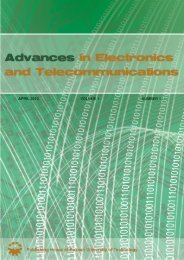november 2010 volume 1 number 2 - Advances in Electronics and ...
november 2010 volume 1 number 2 - Advances in Electronics and ...
november 2010 volume 1 number 2 - Advances in Electronics and ...
You also want an ePaper? Increase the reach of your titles
YUMPU automatically turns print PDFs into web optimized ePapers that Google loves.
ADVANCES IN ELECTRONICS AND TELECOMMUNICATIONS, VOL. 1, NO. 2, NOVEMBER <strong>2010</strong> 51<br />
Improv<strong>in</strong>g Statistical Properties of Number<br />
Sequences Generated by Multiplicative Congruential<br />
Pseudor<strong>and</strong>om Generator<br />
Abstract—A new method of improv<strong>in</strong>g the properties of <strong>number</strong><br />
sequences produced by a multiplicative congruential pseudor<strong>and</strong>om<br />
generator (MCPG) was proposed. The characteristic<br />
feature of the method is the simultaneous usage of <strong>number</strong>s<br />
generated by the sawtooth chaotic map, realized <strong>in</strong> a f<strong>in</strong>itestate<br />
mach<strong>in</strong>e, <strong>and</strong> symbols produced by the same map. The<br />
period of generated sequences can be significantly longer than<br />
theperiodof sequencesproducedbyamultiplicativecongruential<br />
pseudor<strong>and</strong>om generator realized <strong>in</strong> the same mach<strong>in</strong>e. It is<br />
shown that sequences obta<strong>in</strong>ed with the use of the proposed<br />
method pass all statistical tests from thest<strong>and</strong>ard NISTstatistical<br />
test suite v.1.8.<br />
Index Terms—pseudor<strong>and</strong>om generators, shuffl<strong>in</strong>g, comb<strong>in</strong>ed<br />
generators, sequences of symbols, statistical properties<br />
Mieczysław Jessa<br />
I. INTRODUCTION<br />
PSEUDORANDOM <strong>number</strong> sequences are used <strong>in</strong> many<br />
fieldsof science.Everyprogramm<strong>in</strong>glanguageprovidesa<br />
pseudor<strong>and</strong>om <strong>number</strong> generator that produces a sequence of<br />
nonnegative <strong>in</strong>tegers {p0, p1, ...} with <strong>in</strong>teger upper bound b,<br />
<strong>and</strong>thenuses {x0 = p0/b, x1 = p1/b, ...} asanapproximation<br />
of an <strong>in</strong>dependent <strong>and</strong> identically distributed (i.i.d.) sequence<br />
from unit <strong>in</strong>terval I = (0, 1). In almost all programm<strong>in</strong>g languages,<br />
<strong>number</strong>s {p0, p1, ...} are generated by a multiplicative<br />
congruential pseudor<strong>and</strong>om generator (MCPG) of the form<br />
pn = (apn−1) mod b n = 1, 2, .... (1)<br />
The properties of generated sequences depend strongly on the<br />
choice of two parameters: a multiplier a <strong>and</strong> a modulus b. To<br />
obta<strong>in</strong> maximal-length sequences (m-sequences), modulus b<br />
hastobe aprime<strong>number</strong><strong>and</strong>multiplier ahastobe aprimitive<br />
element modulo b [1]–[3]. Because the value for b is usually<br />
determ<strong>in</strong>ed by the <strong>number</strong> of bits used to encode <strong>number</strong>s,<br />
the statistical properties of generated sequences depend on the<br />
choice of the multiplier. In general, the choice of a “good” a<br />
is not simple <strong>and</strong> the <strong>number</strong>of multipliersgenerat<strong>in</strong>g<strong>number</strong><br />
sequences with good statistical properties is quite small [1],<br />
[2].<br />
In this paper, we propose a new method of improv<strong>in</strong>g<br />
properties of m-sequences produced by generator (1). The<br />
method exploits a sequence of symbols produced by the sawtooth<br />
chaotic map, implemented <strong>in</strong> computer <strong>in</strong> the modular<br />
arithmetic. The sequence is used to shuffle the output stream<br />
of MCPG. The same stream is shuffled <strong>in</strong> different ways,<br />
M. Jessa is with the Poznan University of Technology, Faculty of <strong>Electronics</strong><br />
<strong>and</strong> Telecommunications (e-mail: mjessa@et.put.poznan.pl).<br />
produc<strong>in</strong>g different sequences. The obta<strong>in</strong>ed sequences are<br />
comb<strong>in</strong>ed <strong>in</strong>to a s<strong>in</strong>gle sequence which forms the output<br />
stream. The generation of successive <strong>number</strong>s is slightly<br />
slower but we obta<strong>in</strong> additional control parameters (degrees<br />
of freedom) which can be used for improv<strong>in</strong>g the statistical<br />
properties of generated sequences, <strong>in</strong>clud<strong>in</strong>g the possibility<br />
of <strong>in</strong>creas<strong>in</strong>g the period of the sequences. The statistical<br />
properties of output streams are verified with the use of the<br />
st<strong>and</strong>ard NIST statistical test suite v.1.8 [4].<br />
This paper is organized as follows. Section II describes the<br />
method <strong>and</strong> the period of generated sequences. The results<br />
of the statistical tests from the st<strong>and</strong>ard NIST statistical test<br />
suitev.1.8,appliedtosequencesproducedbytheMCPG<strong>and</strong>to<br />
sequences produced by the proposed generator, are presented<br />
<strong>in</strong> Section III. Conclusions are drawn <strong>in</strong> Section IV.<br />
II. THE METHOD<br />
One of the characteristic features of many pseudor<strong>and</strong>om<br />
<strong>number</strong> generators is that <strong>number</strong>s obta<strong>in</strong>ed <strong>in</strong> the iterative<br />
procedure are simultaneously the output of the generator.<br />
MacLaren <strong>and</strong> Marsaglia suggested that the output stream of<br />
l<strong>in</strong>ear congruential pseudor<strong>and</strong>om <strong>number</strong> generator should<br />
be shuffled by us<strong>in</strong>g another, perhaps simpler, generator to<br />
obta<strong>in</strong> sequences with better statistical properties [2], [3].<br />
The first generator produces sequences which fill a table <strong>and</strong><br />
the second one is used to read off elements from this table.<br />
Because a s<strong>in</strong>gle pseudor<strong>and</strong>om<strong>number</strong>generatorcan be used<br />
to generate <strong>in</strong>dependent pseudor<strong>and</strong>om <strong>number</strong>s, it can also<br />
be used to shuffle itself [2], [3]. This method, us<strong>in</strong>g only one<br />
generator, was applied by Gebhardt to improve the statistical<br />
properties of <strong>number</strong> sequences produced by the Fibonacci<br />
generator[5].In1976Bays<strong>and</strong>Durhamproposeda methodof<br />
us<strong>in</strong>g a s<strong>in</strong>gle generatorto shuffle <strong>number</strong>sequencesproduced<br />
by the MCPG, known as RANDU [6]. Although shuffl<strong>in</strong>g can<br />
improvethe statistical propertiesof sequencesproducedby the<br />
MCPG, it is <strong>in</strong>sufficient to ensure that all statistical tests from<br />
the st<strong>and</strong>ard NIST statistical test suite v.1.8 could be passed<br />
for many a. Another approach uses comb<strong>in</strong>ed generators. In<br />
such type of generator the output streams of two or more<br />
generators (called source generators) are comb<strong>in</strong>ed, usually<br />
with the use of modulo 2 operation, <strong>in</strong>to a s<strong>in</strong>gle stream. The<br />
output sequence of the comb<strong>in</strong>ed generator has significantly<br />
longer period <strong>and</strong> better statistical properties than the output<br />
sequences of the source generators. Examples of comb<strong>in</strong>ed<br />
generators can be found, e.g., <strong>in</strong> [1], [3]. To achieve a positive







